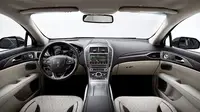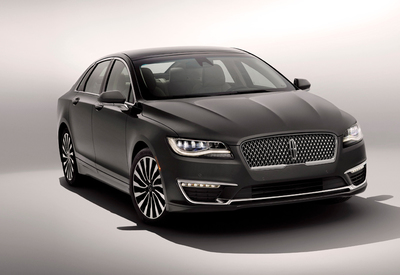2017 Lincoln MKZ Hybrid Review by Carey Russ +VIDEO
Lincoln MKZ Hybrid combines luxury comfort with good fuel economy, and new style
DRIVING DOWN THE ROAD WITH CAREY RUSS
• SEE ALSO: Lincoln Research and Buyers Guide
Lincoln has been re-invented once again, with a new design language introduced on its new premium Continental. Which also graces its other sedan, the entry-luxury MKZ. The MKZ gets more than a styling refresh, as the old 3.7-liter, 300-horsepower V6 that was the premium powerplant is replaced by a 3.0-liter twin-turbo V6 with 350 horses in front-wheel drive trim, or 400 with all-wheel drive. The standard engine continues to be a 2.0-liter four cylinder that makes 245 horsepower. Like the 3.0 V6, it’s turbocharged and uses direct fuel injection for improved power, efficiency, and fuel economy (with a light foot).
Power can be important in the luxury class. But so can fuel efficiency, and for entry-luxury buyers who want that, Lincoln has the MKZ Hybrid. Lincoln’s hybrid system is, unsurprisingly, that of parent Ford, as used in the MKZ’s cousin Fusion. It’s a full series-parallel system that seamlessly blends power from a 2.0-liter Atkinson-cycle gasoline engine and a permanent magnet AC synchronous electric motor for smooth, efficient, and quiet operation befitting a luxury car. No, it’s not a quick as even the 2.0T, never mind the 3.0T. But with real-world fuel economy in the 35 to 40-mpg range, it’s far better. And in some parts of the country, hybrids are eligible for special commute-lane privileges. Best, while most other companies charge a premium for their hybrids, the Lincoln MKZ hybrid carries the same base MSRP as the 2.0T, currently $35,170.
Lincolns have been criticized in the past as being merely re-badged Fords. But similar criticism could be leveled at all other luxury automakers who are part of organizations that build multiple lines, especially for their entry-luxury vehicles. In the past, the method was often little more than a different grille and fancier interior, a practice known, pejoratively, as badge engineering. Today, the game is "platform-sharing", meaning sharing underlying structural and suspension bits and engines, but with distinctive exterior and interior styling. Economy of scale is the operative consideration here -- use what you have, don't un-necessarily reinvent it. Yes, the MKZ is based on the same platform as the Ford Fusion. But while it started, back in 2006 as the Zephyr, looking very much like a Fusion with a Lincoln grille, it has moved ever further from its cousin, inside and out. At this point, nothing major that you can see is shared. The 3.0T engine is unique to Lincoln, and while the hybrid powertrain is shared, see economy of scale. Maybe at the far upper end of the market paying more for less makes sense, maybe. Not where the MKZ competes.
This week’s test car is a bit unusual. It was built expressly as a test fleet vehicle, with “vehicle not for sale” placed where the MSRP would normally be in the window sticker. Some of the option packages listed were not available through the “build your car” option on the consumer web site. These included technology and climate option packages, heated outboard rear seats and steering wheel, and the Revel Ultima audio system. These may be standard equipment, or not. Manufacturers do change equipment and pricing through the model year, and with differences in different parts of the country. YMMV, as the old saying goes. As equipped, this MKZ Hybrid was a fine contemporary implementation of a traditional American luxury car, size medium. With all of the expected luxury fare — except, surprisingly, a sunroof — in an elegant but unostentatious package. Sports-luxury it was not, but there’s the AWD 3.0T for that. Call it comfort-luxury with hybrid fuel economy and quiet, and a good place to spend a long day on the road.
APPEARANCE: Usually, a mid-product cycle refresh means small tweaks to the grille, lights, maybe fenders. Small parts that are relatively inexpensive to change. There is a bit more than that here, as the new grille means a new hood, headlights, and front fascia. And possibly minor changes to the front fenders around the headlights. Everything behind that is the same. Surprisingly, the result is cohesive, so kudos to Lincoln’s styling team. A noteworthy styling trick is the gloss black panel on the trunk behind the rear window that, from a distance, gives the appearance of a larger rear window without drawbacks like excessive summer heat. The chopped “Kammback” rear and its distinctive full-width LED taillight assembly continue unchanged.
 |
COMFORT: Style, convenience, function, and comfort are all expected in a luxury car. All are found here. Leather seating, fronts heated and cooled, outboard rear heated, a heated steering wheel with power adjustment and controls for audio, information, cruise, phone, and other systems, plus pretty much every contemporary luxury convenience. Function and comfort are not sacrificed to fashion -- the programmable LCD instrument display is relatively simple to use as such things go, and shows all necessary information and then some. Seat comfort is very good, and no complaints from rear passengers, either. Anything that can be power-adjustable is, and small LED lights in the exterior door handle wells add convenience at night. The major interior difference from previous years is found in the center stack, where the Sync 3 infotainment system does away with the previous touch-sensitive sliders below the touchscreen in favor of buttons and knobs for audio and climate control systems. As before, phone, audio, navigation, some climate, and information systems are controlled through the touchscreen. As with any electronic device, there is a learning curve.
The strangest interior feature is next to the screen -- buttons marked (top to bottom) P, R, N, D, L. Oh… that's why there is no shift lever on the console, just cupholders and storage. Given that the CVT controlling the powertrain is not amenable to manual shifting, it's a good solution, even if parking valets may be surprised at first. It also allows two useful storage trays under the console top. The rear seat is spacious for the MKZ's size, and outboard passengers get first-class accommodation. A center console/armrest with a ski-passthrough behind is typical in luxury sedans. The 60/40 split-folding seatback is not, nor is it usual in a hybrid. Kudos to Lincoln for providing some utility -- this is entry-luxury, after all. Customers are not likely to have staff to send things ahead to the summer house. Trunk capacity is compromised by the lithium-ion traction battery, as is the (nonexistent) spare tire — but there is still plenty of useful room in the trunk.
SAFETY: Sturdy construction, a full complement of airbags, four-wheel antilock disc brakes assisted by regenerative braking, the Personal Safety System, the SOS Post-Crash Alert System, a rear-view camera, a tire-pressure monitoring system, and a perimeter antitheft alarm are some of the MKZ Hybrid's standard safety systems. Most high-tech safety-enhancement systems, including blind-spot and lane-departure warning systems, are optionally available.
RIDE AND HANDLING: This is a modern international luxury sedan, with a fully-independent MacPherson strut / multilink suspension that is tuned moderately softly for comfort, but correctly-damped so there is none of the wallowing and swaying that was part of the American luxury car experience in the bad old days. It’s built for comfort, not for speed. The electrically-assisted steering is on the light side, but that is as expected for a front-wheel drive luxury car. The MKZ Hybrid is quiet and smooth, and, with a possible 500-mile range, comfortable enough to drive that distance.
PERFORMANCE: The rationale for a hybrid is improved fuel economy, not maximum performance. For that in an MKZ, see the AWD 3.0T. That said, the MKZ Hybrid has no difficulty in traffic. With a system maximum of 188 horsepower, acceleration is adequate rather than blistering -- 0-60 in around 9.5 seconds. Performance in the hybrid realm is more about fuel economy than speed and acceleration, and here there are significant advantages. On short trips, when the car may not have warmed up fully, I got low 30s. Not bad, especially considering the MKZ's size, but hardly the advertised 41 city, 38 highway. A longer journey, with a combination of city, highway, and commute traffic driving, saw high 30s, with the week’s average 35. This can vary depending on driving style, and I have a heavy right foot.
An often-overlooked advantage of a hybrid is regenerative braking, in which magnetic drag from the traction motor being used as a generator helps slow the vehicle in a manner similar to compression braking in internal combustion engine long ago. Here, it is integrated into the braking system, and the brakes work very well indeed. The powertrain is identical to that of the Ford Fusion Hybrid, a full series-parallel system comprised of a 2.0-liter Atkinson-cycle four-cylinder gasoline engine (maxima of 141 hp at 6000 rpm and 129 lb-ft of torque at 4000 rpm) and an AC synchronous motor-generator (118 hp and 177 lb-ft maxima) matched to a CVT. Electric motors make maximum torque as soon as they start to turn, so that 177 lb-ft is nice and noticeable when needed. Throttle response is linear and without looking at the power diagram on the information screen it can be hard to tell what is actually moving the car. Appropriately for a luxury car, it's smooth and usually silent, with engine noise really only noticeable under full throttle.
CONCLUSIONS: The Lincoln MKZ Hybrid combines luxury comfort with good fuel economy, and new style.
SPECIFICATIONS
2017 Lincoln MKZ Hybrid
Base Price $ 35,170
Price As Tested $ n/a
Engine Type DOHC 16-valve Atkinson-cycle inline 4-cylinder with variable intake cam phasing
Engine Size 2.0 liters / 122 cu. in.
Horsepower 141 @ 6000 rpm
Torque (lb-ft) 129 @ 4000 rpm
Electric traction motor permanent-magnet AC synchronous
Horsepower 118 (88kW)
Torque 177 lb-ft
Battery 1.5kwH Li-ion 35kW max power
Maximum system horsepower 188
Transmission computer-controlled CVT
Wheelbase / Length 112.2 in. / 193.9 in.
Curb Weight n/a lbs.
Pounds Per Horsepower n/a
Fuel Capacity 13.5 gal.
Fuel Requirement 87 octane unleaded premium gasoline
Tires P245/40R19 Michelin Green X m+s
Brakes, front/rear vented disc / solid disc, plus regenerative braking
Suspension, front/rear independent MacPherson strut / independent multilink
Drivetrain transverse front engine and motor, front-wheel drive
PERFORMANCE
EPA Fuel Economy - miles per gallon city / highway / observed 41 / 38 / 35
0 to 60 mph est 9.5 sec
OPTIONS AND CHARGES
n/a



